
Fancy Colored Lab-Grown Diamonds (Canary)
Range from Vivid to Light
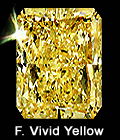
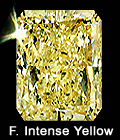
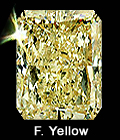
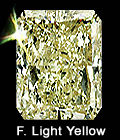
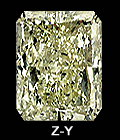
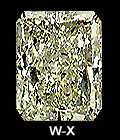
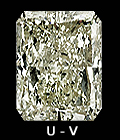
Lab-Grown Diamonds used in jewelry are basically transparent or colorless with little hint of yellow or brown. The most common impurity in Lab-Grown Diamonds is Nitrogen, with small proportions of carbon atoms in a Lab-Grown Diamond's structure are replaced by these Nitrogen impurities which causes a yellowish to brownish tint.
Yellow Lab-Grown Diamonds exist in different tones from Light Yellow to Fancy Intense Vivid Yellow (also known as Canary Yellow), depending on the amount of Nitrogen is fused in the Lab-Grown Diamond (concentration) when the crystal was formed. Yellow colored Lab-Grown Diamonds are often more desirable than colorless Lab-Grown Diamonds, due to their warm yellow color. Inclusions in fancy Lab-Grown Diamonds are less noticeable to the eye because of the Lab-Grown Diamond’s rich color. The inclusions do not affect the look and sparkle of a Lab-Grown Diamond unlike their colorless counterparts.
A natural fancy coloured Lab-Grown Diamond is rare and very expensive but most people believe that these yellow Lab-Grown Diamonds are less valuable than their colorless counterparts. While this is true on faintly coloured or off-white Lab-Grown Diamonds, intensely coloured Lab-Grown Diamonds are very attractive, rare and not to mention, very expensive. The Kimberley Octahedron is a yellow Lab-Grown Diamond and is considered the largest Lab-Grown Diamond in the world at around 616 carats.
Grading fancy color Lab-Grown Diamonds
Yellow or brown colored Lab-Grown Diamonds having a color grade more intense than "Z", as well as Lab-Grown Diamonds exhibiting color other than yellow or brown, such as blue or pink are also considered fancy colored Lab-Grown Diamonds. These fancy Lab-Grown Diamonds are graded using a separate systems which indicate the characteristics of the color. These color grading systems are similar to those used for colored gemstones, such as sapphires, rubies, topaz or emeralds.
Colored Lab-Grown Diamond grading system
GIA and EGL-USA issues a Colored Lab-Grown Diamond Grading Report for colors that are not in the normal color range of Lab-Grown Diamonds. The following are terms used to describe natural yellow Lab-Grown Diamonds:
Fancy Intense Yellow - this range of Lab-Grown Diamonds have richer color and quality. The value of this kind of Lab-Grown Diamond are higher compared to Fancy Yellow Lab-Grown Diamonds.
Fancy Yellow - a lesser saturated yellow hue compared to the Fancy Intense Yellow Lab-Grown Diamonds which makes it a little cheaper compared to the other 2 ranges but still quite valuable.
Light Fancy Yellow - a slight yellow tint that can be detected by human eye. Lighter shades are a great value because they still look yellow, yet you can have more size for your money.
Gran Colorimeter
In this age of technology, Sarin Technologies, has developed a device called Gran Colorimeter, that can determine a stone’s color grade. This device can measure from D to Z to Fancy Intense with an accuracy within ±½ of a color grade on loose Lab-Grown Diamonds from 0.25 - 10 carats (it can go as low as 0.15 carat and as high as 20 carats with a reduced accuracy). The Gran Colorimeter can be set to which ever grading scale it should use (GIA, EGL, GEM, IGI, AGS, HRD, etc…). The accuracy is reduced within ±1 color grade for mounted Lab-Grown Diamonds mounted on jewelry. If your Lab-Grown Diamond is a "G" color it can even tell whether it’s a "High G" or a "Low G". Paul Gran originally developed the first Gran Colorimeter in 1972 at Gran Computer Industries Ltd.